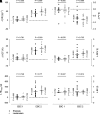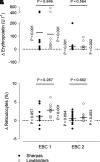Marked hemoglobin mass expansion and plasma volume contraction in Sherpas acclimatizing to 5,400 m altitude
- PMID: 39508897
- PMCID: PMC11687824
- DOI: 10.1152/japplphysiol.00247.2024
Marked hemoglobin mass expansion and plasma volume contraction in Sherpas acclimatizing to 5,400 m altitude
Abstract
In lowlanders, high altitude (HA) acclimatization induces hemoconcentration by reducing plasma volume (PV) and increasing total hemoglobin mass (Hbmass). Conversely, Tibetan highlanders living at HA are reported to have a similar hemoglobin concentration ([Hb]) as lowlanders near sea level, and we investigated whether this reflects alterations in the PV or the Hbmass response to HA. Baseline assessment of PV and Hbmass was performed by carbon monoxide rebreathing at low altitudes (∼1,400 m) in Sherpas (an ethnic group of Tibetans living in Nepal) and native lowlanders. Participants then ascended to the Everest Base Camp (EBC) (5,400 m), where further measurements were performed after ∼2 days (EBC 1) and ∼6 wk (EBC 2). While on EBC 1 an increase in [Hb] was observed in lowlanders (P = 0.004) but not in Sherpas (P = 0.179), marked increases in [Hb] were observed in both groups on EBC 2 (P < 0.001). On EBC 1, Hbmass (Sherpas, P = 0.393; lowlanders, P = 0.123) and PV (Sherpas, P = 0.348; lowlanders, P = 0.172) were not different from baseline in either group, while circulating erythropoietin was increased in both groups (P < 0.001). On EBC 2, large increases in Hbmass and reductions in PV were observed along with elevated circulating erythropoietin in both groups (all P < 0.002). Neither the increases in erythropoietin on EBC 1 (P = 0.846) or EBC 2 (P = 0.564) nor the expansion of Hbmass (P = 0.771) or reduction in PV (P = 0.099) on EBC 2 differed between the groups. We conclude that the hematological response of Sherpas to extended exposure to very high altitudes does not fundamentally differ from that of native lowlanders.NEW & NOTEWORTHY We measured the hematological response to ∼6 wk exposure to an altitude of 5,400 m in Sherpa highland natives and Nepalese lowlanders. While the increase in hemoglobin concentration at high altitudes tended to be smaller in Sherpas than in lowlanders, the two groups experienced a similar reduction in plasma volume and increase in hemoglobin mass. We conclude that the hematological response of Sherpas to high-altitude exposure does not fundamentally differ from that of lowlanders.
Keywords: hematocrit; hemoglobin; hypoxia; plasma volume; sherpas.
Conflict of interest statement
No conflicts of interest, financial or otherwise, are declared by the authors.
Figures





References
-
- Stembridge M, Williams AM, Gasho C, Dawkins TG, Drane A, Villafuerte FC, Levine BD, Shave R, Ainslie PN. The overlooked significance of plasma volume for successful adaptation to high altitude in Sherpa and Andean natives. Proc Natl Acad Sci USA 116: 16177–16179, 2019. doi:10.1073/pnas.1909002116. - DOI - PMC - PubMed
MeSH terms
Substances
Grants and funding
LinkOut - more resources
Full Text Sources

